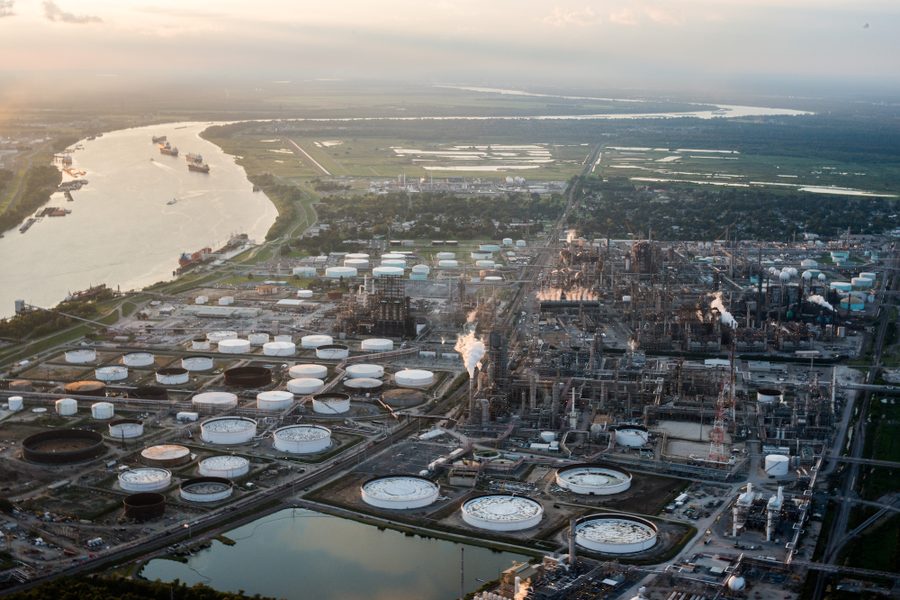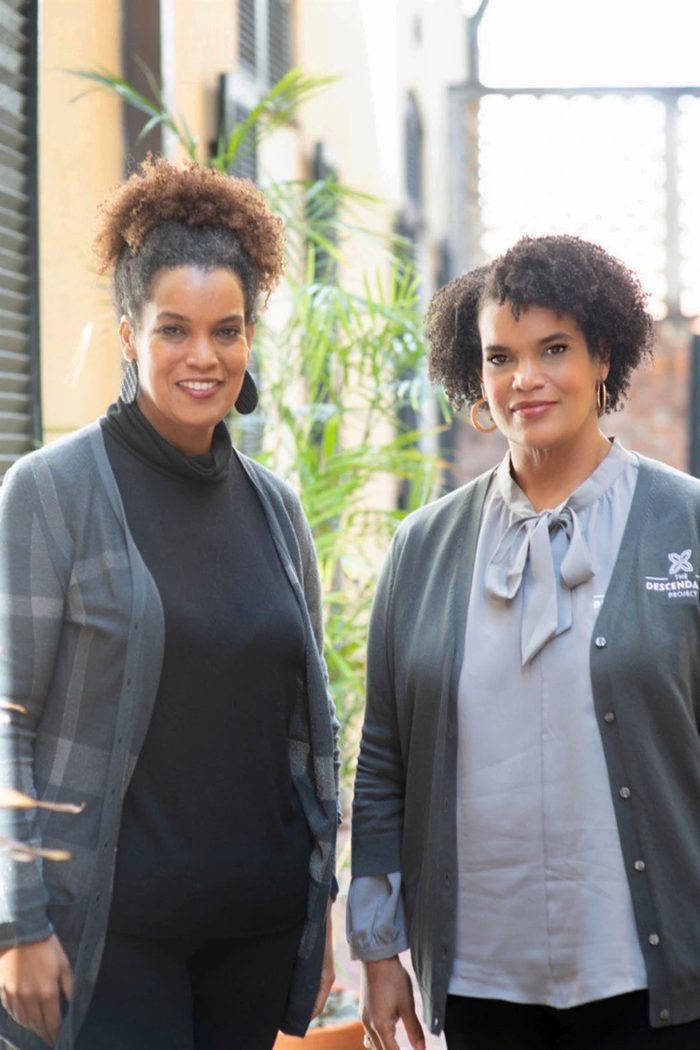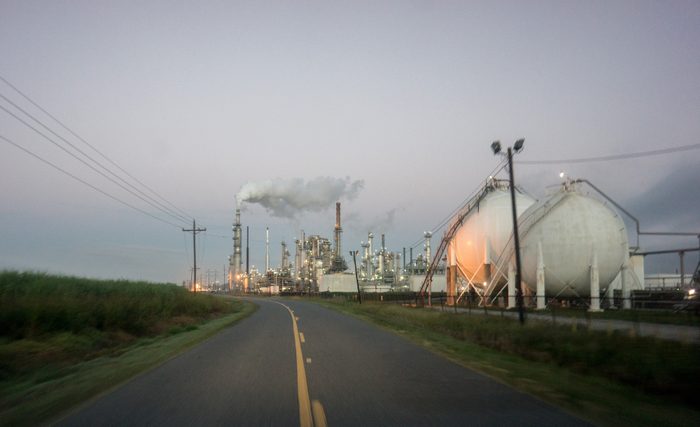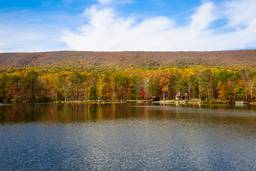Fighting Industrial Development and Defending Black History in Louisiana’s “Cancer Alley”
In Wallace, descendants of enslaved people live on one of the last preserved stretches of Louisiana’s Mississippi River. Now, a massive grain export facility threatens the community’s history and future.
Daja E. Henry

Editor’s Note: This article was originally published by The 19th.
WALLACE, La.— There are only a handful of homes situated on Alexis Court, but there are a whole lot of memories.
At one end of the short street, facing the Mississippi River, is Fee-Fo-Lay Café, run by twin sisters Jo and Joy Banner. The Fifolet, according to local lore, is a spirit that haunts the swamps and guards the treasures of pirate Jean Lafitte. Growing up, the Banner sisters heard a variation of the myth from their grandmother, and the café bears its name as an homage to their grandparents’ stories. Inside, the walls hold the stories and pictures of at least four generations.

Many of their family members live around Fee-Fo-Lay — the family has been in the town of Wallace since its beginnings. Outside of the café, a tree is dedicated to Big Anthony, their ancestor who was enslaved on the nearby Laura Plantation in 1829. The sisters’ great-great grandmother Camellia Aubert Alexis was a midwife who delivered many babies throughout the community and followed up with cookies and candies that she baked. Their great-grandmother Nobia Alexis, a farmer, saved the money she made from selling her chickens’ eggs to buy the land that Jo and Joy’s parents would build their house on.
But the family fears a proposed grain export facility by a Colorado-based developer would mark the end of their community as they know it. The Greenfield Louisiana LLC facility, which has begun work on the site, would consist of 54 silos with a tower as tall as the Statue of Liberty. Renderings show the facility looming over the nearby homes and café. A facility of its kind could also pose a threat to a community already overburdened with pollution from nearby chemical plants, environmental advocates warn.
“They’re trying to clear all of our communities out and make it a true industrial corridor. So we are getting in the way,” Joy Banner said.
In May, the National Trust for Historic Preservation added an 11-mile stretch, including Wallace, to its list of 11 most endangered historic places in 2023 because of the terminal’s threat to its cultural landscape. The land the facility is poised to occupy was formerly part of three plantations, which could contain burial grounds for enslaved people and archaeological artifacts, according to researchers, including a whistleblower whose bosses altered her land survey addressing the site’s historic nature after pressure from Greenfield.
The area encompasses the entire west bank of St. John the Baptist Parish, an oasis of largely undisturbed history in the middle of Louisiana’s “Cancer Alley.” The 85-mile stretch between New Orleans and Baton Rouge, which includes the parish, derives its name from the prevalence of cancer diagnoses and deaths that a 2022 Tulane University study has linked to toxic air pollution caused by a large concentration of industrial plants.
The Banner sisters are now fighting to preserve the history and health of their community.
Wallace is a small town of about 755 people. The majority-Black St. John the Baptist Parish is divided in half by the Mississippi River, with Wallace on the west bank. Sugarcane plantations once lined each side of the river.
Now, a look at both sides of the river reads like a before and after picture. On the parish’s west bank, stalks of sugarcane shoot out of sprawling green fields as far as the eye can see. Small family homes and grand plantation houses that have seen centuries’ worth of births, deaths and memories are sprinkled throughout the never-ending stretches. The west bank’s cultural landscape is largely intact. Homes like the Sorapuru family’s have remained since it was built around 1825.
The east bank has been taken over by a tangle of metal, concrete and smoke. Some plants, like Waterford in neighboring St. Charles Parish, even bear the names of the plantations that occupied the land before them. Layers of rust-colored dust coat everything, including roads, buildings and a once-green welcome sign near Atlantic Alumina Gramercy Operations, a plant that creates a key ingredient in aluminum. The plant has had 370 safety violations within the past two years. Earlier this year, the United States Department of Justice suedDenka Performance Elastomer, a neoprene plant, to require it lower its emissions of chloroprene, a chemical which the department referred to as “likely” cancer-causing.
In 2020, the Banner sisters founded the Descendants Project to amplify the narratives of enslaved people and their descendants, combatting the whitewashed antebellum stories perpetuated by plantation tourism. At the time, Joy worked at the Whitney Plantation, about a mile away from the café, which has attracted hundreds of thousands of visitors with its focus on the lives of the enslaved. She and her sister descend from a woman named Anna who was enslaved on the plantation.
Shortly after founding the Descendants Project, they found out about Greenfield Louisiana’s plans and shifted their focus to fighting the industrial project and repairing the harms left by slavery. They’ve hosted programming to uplift the community economically, such as recent grant writing and costume design training to equip residents to work in different industries, and restorative programs such as a cleanup of Willow Grove, a historic African-American cemetery.
Joy Banner said that by the time Greenfield Louisiana’s facility was on her radar, the company had been privately talking with St. John the Baptist Parish leadership for years without citizen input.
“It’s their intent, as many of these other industries to come in — railroad the community to immediately think that you don’t have the power to fight back, that it’s a done deal so you won’t fight and either start selling off your land or just sit back and be inundated and take the pollution,” Joy Banner said.
Members of parish leadership did not respond to requests for comment.

The Descendants Project is suing the parish over that zoning. They argue that it was “part of an illegal scheme that involved extortion, money-laundering, and threats of legal action against neighboring residents to discourage their resistance to selling their property.” If the zoning is overturned, it would block the Greenfield project. St. John the Baptist Parish’s 40th Judicial District Court held a hearing on this lawsuit May 11, and a decision is expected soon.
The Tulane Environmental Law Clinic is also planning to file a complaint on behalf of the Descendants Project challenging the way the Louisiana Department of Environmental Quality issues air permits, according to Kimberly Terrell, a researcher with Tulane Environmental Law Clinic. She said the current system has no consideration for environmental justice and the existing pollution burden.
“What Greenfield is failing to recognize is that they are not the only sources of pollution in this area,” she said.
The grain dust the facility will emit could cause respiratory problems for residents in the area, according to the Occupational Safety and Health Administration. It also may contain contaminants such as insect parts, fecal matter, pollen and fungus spores. Its very small particles can get deep into the lungs or the bloodstream. These foreign particles in a person’s body could increase the risk of asthma, COPD, inflammation, chronic bronchitis and, if breathed in consistently over time, lung cancer. The dust can also carry toxic chemicals into the body and worsen the effects of the pollution they already inhale daily.
In addition to the lawsuits, the National Trust for Historic Preservation is asking people to contact the U.S. Army Corps of Engineers to ask that it deny Greenfield’s building permit, as its construction would threaten nationally significant historic resources.
Greenfield argues that its project will bring jobs to boost the local economy and that its facilities will be low-emissions. The Descendants Project says the company’s arguments are misleading.
Researchers in 2019 found that very few of the jobs brought by industrial plants go to local community members. Instead, they bring in skilled workers and equipment operators from outside of the communities to do these jobs, doing nothing to alleviate poverty. In 2018, Formosa, a plastics company seeking to build its plant in neighboring St. James Parish, planned to have man camps built to house workers they would bring in.
Instead of depending on industry to create jobs, Joy Banner envisions self-sufficient ways to build the community’s economy, such as filling the needs for coastal restoration, cleanup from the toxic pollution and tourism relating to the area’s rich history.
“This cannot be framed as jobs or no jobs. It needs to be framed as what kind of jobs do we want for the future? What kind of economic development do we want and need for the future?” said Marc Morial, who is also a descendant of Anna and the former mayor of New Orleans.
Terrell said Greenfield is also misleading community members about its environmental impact.
“If a plant has zero emissions, they don’t need a permit,” she said, referencing an air permit granted by the Louisiana Department of Environmental Quality. “You don’t need permits for things that don’t pollute. So it’s very disingenuous for a company to get their air permit without public participation and then try to convince the community that they don’t even need their air permit because they’re not going to pollute.”
Tish Taylor, a resident of the east bank, is a leader of Concerned Citizens of St. John. Her father founded the group after a National Air Toxics Assessment released in 2015 revealed the Denka facility in Louisiana was emitting huge quantities of chloroprene. A later EPA assessment, released in 2018, found that the risk of getting cancer in St. John the Baptist Parish is 47 times higher than the national average.
Taylor watched at a press conference that the Descendants Project organized Saturday on a levee overlooking the E.J. Caire & Co. Store, a building listed on the National Register of Historic Places, as a slate of speakers heralded the history of the area. Though the historic significance is not lost on her, she’s more concerned with the future.
“They’re preserving something, but there won’t even be people here to enjoy it or people to even discuss or pass it down to,” Taylor said. “To ignore that we are being poisoned right now, it’s just ludicrous. It’s madness.”
Taylor drives an old beige Toyota with “Climate Action NOW” and “FOR OUR KIDS” painted in bold, colorful letters across the driver’s side doors. Children’s handprints adorn the back bumper.
“We are disappearing. We are dying with cancer and … so many things linked to our immune systems being compromised by chloroprene, particulate matter, ethylene oxide. This needs to be at the front of every conversation to preserve my family.”
The Banner sisters and Taylor agree on the reason for their parish’s current predicament: slavery and its enduring legacy.
Once slavery was outlawed and plantations were no longer profitable, politicians began welcoming industry. Following World War II, the increased dependency on petroleum products seemed to be a promise of prosperity for these communities. Instead of prosperity, they got what Louisiana Trust for Historic Preservation Executive Director Brian Davis called industrial colonialism.
“Communities were guaranteed unlimited high-paying jobs and prosperity that never lived up to the promises of outside corporations. These companies paved over local history and culture, mined its people and polluted the air and water,” Davis said.
A 2022 study by Tulane University’s Environmental Law Clinic researchers found stark racial disparities in exposure to toxic pollution. The location of chemical plants is more closely linked to the racial makeup of a place than the availability of infrastructure to support plants.
“You’re talking about descendants of slaves who bought their land from sharecropping,” Taylor said. “This is our history, period. But instead of letting people come in and build along the river, [parish leadership] set it up to be a sacrifice zone.”
The history of the injustices of slavery and of this country lies out in the open in Wallace. The Banner sisters, now with the muscle of national historic organizations backing them, want to keep it that way.
There’s still the possibility that following a Descendants Project win, Greenfield could seek alternatives to push its project through. But as Joy Banner said, the sisters are getting in the way.
Daja E. Henry is a 2022-2023 Frances Ellen Watkins Harper editorial fellow at The 19th. Explore their work.




